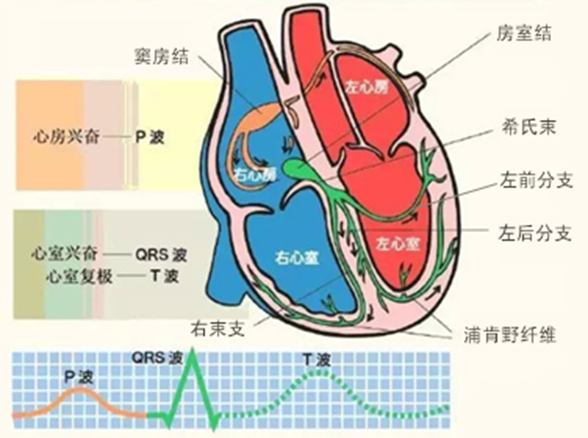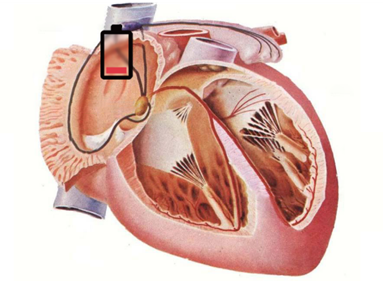If you have slower heart rate or palpitation occasionally, and the doctor recommends pacemaker implantation after you take the 24-hour Holter monitor test, you may be nervous and wonder: why is a pacemaker needed? I have no dizziness, amaurosis, fatigue, syncope, and other discomfort.
Maybe that's because the doctor finds that you have sinus arrest via Holter.
1. What is sinus arrest?
In the previous session, Lectures on pacemaker | Indications for pacemaker, sinus rhythm has been explained. It refers to the heart rhythm initiated from the sinoatrial node (SA node).
Let’s look at the relationship between the electrical impulse discharged by the SA node and electrocardiogram

The SA node sends impulses to the atria, and the atria are activated to generate P wave, which is then conducted down to the ventricles through A-V node and His bundle. Then QRS wave is produced in ventricles, and ventricular repolarization generates T wave.
This is a normal electrocardiogram.

In the red oval circle is the P wave generated by the atrium when the SA node is activated. The red arrow refers to the QRS wave, representing a heartbeat. It can be seen that the heartbeat is regular, with the heart rate of 60 bpm.
But sometimes, the SA node will suddenly stop working for a period of time, during which no instructions are given, and this is called sinus arrest.

The two red arrows shown above have an interval of nearly 5 seconds, with no P wave in the middle. That is to say, the SA node does not give any instructions during the 5 seconds. Its subordinate "commanders"also stop working, without sending any electrical impulse. The heart, therefore, does not beat during these 5 seconds. Some people's cardiac arrest can last for more than ten seconds. If the arrest occurs during the day, the patient may experience dizziness, amaurosis, and syncope. Many people have the arrest at night without these symptoms, but they are also at risk of sudden cardiac death!
2. What causes sinus arrest?
Most cases of sinus arrest are not caused by clear underlying heart diseases, but simply the degeneration of SA node function (i.e., "aging" of the power supply).

Other heart diseases, such as coronary heart disease, cardiomyopathy, myocarditis, etc., can lead to or accelerate the dysfunction of the SA node (including other conduction systems).
Some patients may have sinus arrest because they use certain drugs (such as β-blockers or antiarrhythmic drugs) or have electrolyte disorders (such as hyperkalemia), hypothyroidism, etc., which will also cause the damage or dysfunction of the heart’s“power source”- SA node.
3. How is sinus arrest treated?
Sometimes the cause is reversible, such as myocarditis, electrolyte disorders, medication or hypothyroidism, and most patients can avoid pacemaker implantation if these conditions are properly treated.
Most sinus arrests, however, are caused by the degeneration of SA node, which requires pacemaker implantation to completely solve the problem.
>>Other things you need to know
If you occasionally have sinus arrest with less than 3 seconds, with no dizziness, fatigue, amaurosis, you can regularly follow up for Holter and decide whether you need to implant a pacemaker.
For frequent sinus arrest lasting for more than 3 seconds, even if there are no clinical symptoms, pacemaker implantation is recommended to prevent sudden cardiac death.However, sometimes you may see a long interval on the Holter, which is not sinus arrest, but sinoatrial block. It’s hard to tell the difference between a high degree of sinoatrial block and a sinus arrest, but the principles of treatment are the same, and we’ll talk more about that next time.
Some actions to increase vagal tension, such as pressing the eyes, massaging the carotid sinus, and stimulating the pharynx can also lead to transient suppression of SA node function and thus cause sinus arrest, so don't try to do that.
Of course, people with paroxysmal supraventricular tachycardia can try these movements to stop the tachycardia (do not try this by yourself, please do it under professional guidance if necessary).